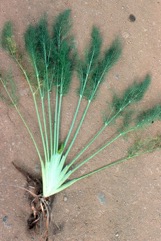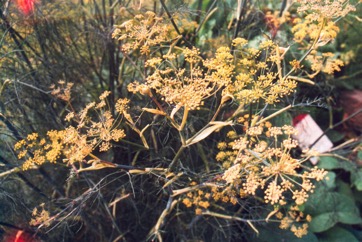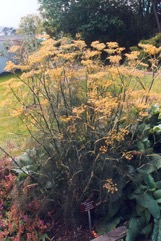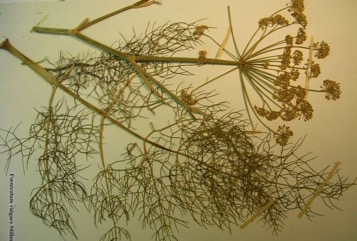Fennel, Common fennel

A temperate plant. It grows well in a Mediterranean climate. It grows well on dry and stony calcareous soils. It grows up to at least 2200 m altitude in the tropics. It grows better during the drier season at altitudes over 500 m. In PNG is grows between 1,400-2,200 m above sea level. It is cultivated but also easily grows wild. It is frost hardy. It grows in Nepal to about 2400 m altitude. In Argentina it grows from sea level to 1,000 m above sea level. It suits hardiness zones 5-10. Tasmania Herbarium. In Hobart Botanical gardens. In Yunnan.
Also known as:
Adas, Adeh manih, Arapcaci, Asi, Badishep, Badisopu, Besbes, Dereotu, Elbesbas, Fenchel, Fenneru, Fenocchio salvacce, Fenouil, Finocchio selvatico, Fonoll, Funcho, Hades, Hinojo, Hinojo amargo, Hui xiang, Jintan manis, Jira, K'ama, Kokar ot, Komorac, Lebgoul, Madhurica, Maduru, Maraho, Masara, Masaro, Mauri, Millua, Morac, Mouri, Navadni komarček, Panmuhori, Peddajilakara, Phak chi, Rezene, Samon-saba, Samouk-saba, Saunf, Shamar, Shepu, Shombu, Shumar, Sonf, Sonp, Sopu, Sounp, Tseretso, Variari, Variyali, Vinkel, Wamssa, Yi ra, Yira
Synonyms
- Anethum dulce DC.
- Anethum foeniculum L.
- Anethum minus Gouan
- Anethum panmori Roxb.
- Anethum pannorium Roxburgh
- Anethum piperitum Ucria
- Anethum ruprestre Salisb.
- Foeniculum azoricum Mill.
- Foeniculum capillaceum Gilib.
- [Invalid] Foeniculum divaricatum Griseb.
- Foeniculum dulce Mill.
- Foeniculum officinale All..
- Foeniculum scoparium Quezel
- and others
Edible Portion
- Seeds, Leaves, Bulb, Herb, Spice, Vegetable, Oil, Roots, Flowers
Where does Fennel grow?
Found in: Africa, Albania, Argentina, Asia, Australia, Bahamas, Balkans, Bangladesh, Bolivia, Bosnia, Brazil, Britain, Bulgaria, Canada, Caucasus, Central America, Chile, China, Cook Islands, Crete, Croatia, Cuba, Cyprus, Dominican Republic, East Africa, East Timor, Egypt, Egypt - Sinai, Ethiopia, Europe, Fiji, France, Georgia, Greece, Haiti, Hawaii, Himalayas, India, Indochina, Indonesia, Ireland, Israel, Italy, Japan, Jordan, Kenya, Korea, Laos, Lebanon, Lithuania, Macedonia, Marquesas, Mediterranean, Malaysia, Mali, Mexico, Morocco, Mozambique, Myanmar, Nepal, New Zealand, Niger, North Africa, North America, NW India, Norway, Pacific, Pakistan, Palestine, Papua New Guinea, PNG, Paraguay, Philippines, Portugal, Qatar, Scandinavia, SE Asia, Sicily, Sinai, Slovenia, South Africa, Southern Africa, South America, Spain, Sri Lanka, St Helena, Sweden, Tasmania, Thailand, Tibet, Timor-Leste, Turkey, Uruguay, United States, Vietnam, West Africa, West Indies, Yugoslavia, Zambia, Zimbabwe
Notes: There is only one Foeniculum species. It can be invasive.
Growing Fennel, Common fennel
Cultivation: Plants can be grown from seed. These can be transplanted. The rootstock of established plants can be used to start new plants. A spacing of 50 cm apart between plants is suitable. (Dill and fennel can cross pollinate and the flavours mix.)
Edible Uses: The top leaves can be boiled and eaten as a flavouring. The young tender central portion and the leaf bases can be chopped and eaten. The root can be cooked and eaten. (It is used in medicine) The seeds can be used as a flavouring. They are used to flavour bread and cakes and in stuffings. It is used in sauces, sausages, stews and salads,
Nutrition Info
per 100g edible portion| Edible Part | Energy (kcal) | Protein (g) | Iron (mg) | Vitamin A (ug) | Vitamin c (mg) | Zinc (mg) | % Water |
|---|---|---|---|---|---|---|---|
| Bulb raw | 31 | 1.2 | 0.7 | 13..4 | 12 | 0.2 | 90.2 |
| Seed | 345 | 15.8 | 18.5 | 14 | 21 | 3.7 | 8.8 |
| Leaves | 31 | 2.9 | 2.9 | - | - | - | 89.2 |
Fennel, Common fennel Photos




References
Aceituno-Mata, L., et al, 2021, The Persistence of Flavor: Past and Present Use of Wild Food Plants in Sierra Norte de Madrid, Spain. Front. Sustain. Food Syst., 11 January 2021
Ali-Shtayeh, M. S., et al, 2008, Traditional knowledge of wild edible plants used in Palestine (Northern West Bank): A comparative study. J Ethnobiol Ethnomed. 4: 13
Al-Qura'n, S. A., 2010, Ethnobotanical and Ecological Studies of Wild Edible Plants in Jordan. Libyan Agriculture Research Center Journal International 1(4):231-243
Ambasta, S.P. (Ed.), 2000, The Useful Plants of India. CSIR India. p 226
Anderson, E. F., 1993, Plants and people of the Golden Triangle. Dioscorides Press. p 211
Ara, R. I. T., 2015, Leafy Vegetables in Bangladesh. Photon eBooks. p 138
Bailey, C. and Danin, A., 1981, Bedouin Plant Utilization in Sinai and the Negev. Economic Botany 35(2): 145-162
Batal, M. & Hunter, E., 2007, Traditional Lebanese recipes based on wild plants: An answer to diet simplification? Food and Nutrition Bulletin, vol. 28, no. 2 (supplement) © 2007, The United Nations University.
Berihun, T. & Molla, E., 2017, Study on the Diversity and Use of Wild Edible Plants in Bullen District Northwest Ethiopia. Hindawi Journal of Botany. Article ID 8383468
Biscotti, N. & Pieroni, A., 2015, The hidden Mediterranean diet: wild vegetables traditionally gathered and consumed in the Gargano area, Apulia, SE Italy. Acta Societatis Botanicorum Poloniae 84 (3): 327-338 (As subsp. piperitum)
Biscotti, N. et al, 2018, The traditional food use of wild vegetables in Apulia (Italy) in the light of Italian ethnobotanical literature. Italian Botanist 5:1-24 (As subsp. piperitum)
Blamey, M and Grey-Wilson, C., 2005, Wild flowers of the Mediterranean. A & C Black London. p 157
Blanco-Salas, J., et al, 2019, Wild Plants Potentially Used in Human Food in the Protected Area “Sierra Grande de Hornachos” of Extremadura (Spain). Sustainability 2019, 11, 456
Bodkin, F., 1991, Encyclopedia Botanica. Cornstalk publishing, p 477
Bonet, M. A. & Valles, J., 2002, Use of non-crop food vascular plants in Montseny biosphere reserve (Catalonia, Iberian Peninsula). International Journal of Food Sciences and Nutrition (2002) 53, 225–248 (As subsp. piperitum)
Bourke, R. M., Altitudinal limits of 230 economic crop species in Papua New Guinea. Terra australis 32.
Bremness, L., 1994, Herbs. Collins Eyewitness Handbooks. Harper Collins. p 171
Brickell, C. (Ed.), 1999, The Royal Horticultural Society A-Z Encyclopedia of Garden Plants. Convent Garden Books. p 441
Brouk, B., 1975, Plants Consumed by Man. Academic Press, London. p 108, 299
Brown, D., 2002, The Royal Horticultural Society encyclopedia of Herbs and their uses. DK Books. p 215
Burkill, H. M., 1985, The useful plants of west tropical Africa, Vol. 5. Kew.
Burkill, I.H., 1966, A Dictionary of the Economic Products of the Malay Peninsula. Ministry of Agriculture and Cooperatives, Kuala Lumpur, Malaysia. Vol 1 (A-H) p 1044
Burnie, G & Fenton-Smith, J., 1999, A Grower's Guide to Herbs. Murdoch Books. p 33
Bussman, R. W., et al, 2016, A comparative ethnobotany of Khevsureti, Samtskhe-Javakheti, Tusheti, Svaneti, and Racha-Lechkhumi, Republic of Georgia (Sakartvelo), Caucasus. Journal of Ethnobiology and Ethnomedicine (2016) 12:43
Bussman, R. W. et al, 2017, Ethnobotany of Samtskhe-Javakheti, Sakartvelo (Republic of Georgia), Caucasus. Indian Journal of Traditional Knowledge Vol. 16(1) pp 7-24
Cerne, M., 1992, Wild Plants from Slovenia used as Vegetables. Acta Horticulturae 318
Cheifetz, A., (ed), 1999, 500 popular vegetables, herbs, fruits and nuts for Australian Gardeners. Random House p 125
Ciftcioglu, C. G., 2015, Sustainable wild-collection of medicinal and edible plants in Lefke region of North Cyprus. Agroforest Syst. Springer
Cordero, S. E., Abello, L. A., & Galvez, F. L., 2017, Plantas silvestres comestibles y medicinales de Chile y otras partes del mundo. CORMA p 176
Crawford, M., 2012, How to grow Perennial Vegetables. Green Books. p 103
Cobley, L.S. (rev. Steele, W.M.) 2nd Ed., 1976, An Introduction to the Botany of Tropical Crops. Longmans. p 249
Cundall, P., (ed.), 2004, Gardening Australia: flora: the gardener's bible. ABC Books. p 606
Curtis, W.M., 1963, The Students Flora of Tasmania Vol 2 p 259
Dashorst, G.R.M., and Jessop, J.P., 1998, Plants of the Adelaide Plains & Hills. Botanic Gardens of Adelaide and State Herbarium. p 114
Della, A., et al, 2006, An ethnobotanical survey of wild edible plants of Paphos and Larnaca countryside of Cyprus. J. Ethnobiol. Ethnomed. 2:34
Dogan, Y., et al, 2004, The Use of Wild Edible Plants in Western and Central Anatolia (Turkey). Economic Botany 58(4) pp. 684-690
Dogan, A., et al, 2014, A review of edible plants on the Turkish Apiaceae species. J. Fac. Pharm. Istanbul, 44(2) pp 251-262
Dogan, Y., 2012, Traditionally used wild edible greens in the Aegean Region of Turkey. Acta Societatis Botanicorum Poloniae 81(4): 329-342
Dolina, K. & Luczaj, L., 2014, Wild food plants used on the Dubrovnik coast (south-eastern Croatia) Acta Soc Bot Pol 83(3):175–181
Dutt, B., et al, 2011, Ethnobotanical Survey of Plants used by Gaddi Tribe of Bharmour Area in Himachal Pradesh. ENVIS Bulletin: Himalayan Ecology 19, 2011
Ertug, F., 2004, Wild Edible Plants of the Bodrum Area. (Mugla, Turkey). Turk. J. Bot. 28 (2004): 161-174
Ertug, F, Yenen Bitkiler. Resimli Türkiye Florası -I- Flora of Turkey - Ethnobotany supplement
Esperanca, M. J., 1988. Surviving in the wild. A glance at the wild plants and their uses. Vol. 1. p 346
Facciola, S., 1998, Cornucopia 2: a Source Book of Edible Plants. Kampong Publications, 18
FAO, 1988, Traditional Food Plants, FAO Food and Nutrition Paper 42. FAO Rome p 295
Fowler, D. G., 2007, Zambian Plants: Their Vernacular Names and Uses. Kew. p 76
French, B.R., 1986, Food Plants of Papua New Guinea, A Compendium. Asia Pacific Science Foundation p 349
Grubben, G. J. H. and Denton, O. A. (eds), 2004, Plant Resources of Tropical Africa 2. Vegetables. PROTA, Wageningen, Netherlands. p 562
Gard. dict. ed. 8: Foeniculum no. 1. 1768
Gonzalez, J. A., et al, 2011, The consumption of wild and semi-domesticated edible plants in the Arribes del Duero (Salamanca-Zamora, Spain): an analysis of traditional knowledge. Genetic. Resour Crop Evolution 58:991-1006 (As Foeniculum vulgare var. piperitum)
Hadfield, J., 2001, The A-Z of Vegetable Gardening in South Africa. Struik p 134
Hadjichambis, A. C., et al, 2007, Wild and semi-domesticated food plant consumption in seven circum-Mediterranean areas. International Journal of Food Sciences and Nutrition. 2007, 1-32.
Hedrick, U.P., 1919, (Ed.), Sturtevant's edible plants of the world. p 311
Hinnawi, N. S. A., 2010, An ethnobotanical study of wild edible plants in the Northern West Bank "Palestine". An-Najah National University. p 91
http://nordicfood lab/org/blog/2102/9/wild-edible-plants-an-overview
Hussey, B.M.J., Keighery, G.J., Cousens, R.D., Dodd, J., Lloyd, S.G., 1997, Western Weeds. A guide to the weeds of Western Australia. Plant Protection Society of Western Australia. p 84
Hutton, W., 1997, Tropical Herbs and Spices of Indonesia. Periplus. p 30
Hu, Shiu-ying, 2005, Food Plants of China. The Chinese University Press. p 597
Irving, M., 2009, The Forager Handbook, A Guide to the Edible Plants of Britain. Ebury Press p 123
Jardin, C., 1970, List of Foods Used In Africa, FAO Nutrition Information Document Series No 2.p 79
Jeambey, Z., et al, 2009, Perceived health and medicinal properties of six species of wild edible plants in north-east Lebanon. Public Health Nutrition: 12(10), 1902-1911
Joyce, D., 1998, The Garden Plant Selector. Ryland, Peters and Small. p 228
Ju, Y., et al, 2013, Eating from the wild: diversity of wild edible plants used by Tibetans in Shangri-la region, Yunnan, China, Journal of Ethnobiology and Ethno medicine 9:28
Kargioglu, M. et al, 2010, Traditional Uses of Wild Plants in the Middle Aegean Region. Human Ecology 38:429-450
Kiple, K.F. & Ornelas, K.C., (eds), 2000, The Cambridge World History of Food. CUP p 433, 1773
Kybal, J., 1980, Herbs and Spices, A Hamlyn Colour Guide, Hamlyn Sydney p 98
Ladio, A., Lozada, M. & M. Weigandt, 2007, Comparison of traditional wild plant knowledge between aboriginal communities inhabiting arid and forest environments in Patagonia, Argentina. Journal of Arid Environments 69 (2007) 695–715
Lamp, C & Collet F., 1989, Field Guide to Weeds in Australia. Inkata Press. p 124
Lazarides, M. & Hince, B., 1993, Handbook of Economic Plants of Australia, CSIRO. p 116
Lentini, F. and Venza, F., 2007, Wild food plants of popular use in Sicily. J Ethnobiol Ethnomedicine. 3: 15 (As Foeniculum vulgare var. piperitum)
Licata, M., et al, 2016, A survey of wild plant species for food use in Sicily (Italy) – results of a 3-year study in four Regional Parks. Journal of Ethnobiology and Ethnomedicine 12:12
Lim, T. K., 2015, Edible Medicinal and Non Medicinal Plants. Volume 9, Modified Stems, Roots, Bulbs. Springer p 43
Liu, Yi-tao, & Long, Chun-Lin, 2002, Studies on Edible Flowers Consumed by Ethnic Groups in Yunnan. Acta Botanica Yunnanica. 24(1):41-56
Low, T., 1991, Wild Herbs of Australia and New Zealand. Angus & Robertson. p 64 (Drawing)
Luczaj, L. et al, 2013, Wild food plants used in the villages of the Lake Vrana Nature Park (northern Dalmatia, Croatia). Acta Societatis Botanicorum Poloniae, 82(4): 275-281
Luczaj, L. et al, 2017, Comfrey and Buttercup Eaters: Wild Vegetables of the Imereti Region in Western Georgia, Caucasus. Economic Botany, 71(2), 2017, pp. 188–193
Mabey, R., 1973, Food for Free. A Guide to the edible wild plants of Britain, Collins. p 126
Malezas Comestibles del Cono Sur, INTA, 2009, Buernos Aires
Manandhar, N.P., 2002, Plants and People of Nepal. Timber Press. Portland, Oregon. p 238
Marinelli, J. (Ed), 2004, Plant. DK. p 455
Martin, F.W. & Ruberte, R.M., 1979, Edible Leaves of the Tropics. Antillian College Press, Mayaguez, Puerto Rico. p 101, 222
Michael, P., 2007, Edible Wild Plants and Herbs. Grub Street. London. p 93
Miguel, E., et al, 1989, A checklist of the cultivated plants of Cuba. Kulturpflanze 37. 1989, 211-357
Molla, A., Ethiopian Plant Names. http://www.ethiopic.com/aplants.htm
Morley, B.D., & Toelken, H.R., (Eds), 1983, Flowering Plants in Australia. Rigby. p 218
Morley, B. & Everard, B., 1970, Wild Flowers of the World. Ebury press. Plate 17
Nassif, F., & Tanji, A., 2013, Gathered food plants in Morocco: The long forgotten species in Ethnobotanical Research. Life Science Leaflets 3:17-54
Nebel, S., Pieroni, A. & Heinrich, M., 2006, Ta cho`rta: Wild edible greens used in the Graecanic area in Calabria, Southern Italy. Appetite 47 (2006) 333–342 (As Foeniculum vulgare subsp. piperitum)
Niwano, Y. et al., 2009, Extensive Screening for Plant Foodstuffs in Okinawa, Japan with Anti-Obese Activity on Adipocytes, in vitro. Plant Foods in Human Nutrition 64:6-10
Ochse, J. J. et al, 1931, Vegetables of the Dutch East Indies. Asher reprint. p 714
Oran, S. A. S., 2015, Selected Wild Aromatic Plants in Jordan. International Journal of Medicinal Plants. Photon 108 (2015) 686-699
Özdemir, E. and Kültür, S., 2017, Wild Edible Plants of Savaştepe District (Balıkesir, Turkey), Marmara Pharm J 21/3: 578-589
Petersen, L. M., et al, 2012, Development of a Compendium of Local, Wild-Harvested Species Used in the Informal Economy Trade, Cape Town, South Africa. Ecology and Society 17(2):26
Pieroni, A., 1999, Gathered wild food plants in the Upper Valley of the Serchio River (Garfagnana), Central Italy. Economic Botany 53(3) pp 327-341
Pieroni, A., et al, 2005, Food for two seasons: Culinary uses of non-cultivated local vegetables and mushrooms in a south Italian village. International Journal of Food Sciences and Nutrition, 56(4): 245-272 (As subsp. piperitum)
Plants for a Future database, The Field, Penpol, Lostwithiel, Cornwall, PL22 0NG, UK. http://www.scs.leeds.ac.uk/pfaf/
Plants of Haiti Smithsonian Institute http://botany.si.edu
PROSEA (Plant Resources of South East Asia) handbook, Volume 13, 1999, Spices.
Purseglove, J.W., 1968, Tropical Crops Dicotyledons, Longmans. p 651
Rashid, H. E., 1977, Geography of Bangladesh. Westview. p 281
Redzic, S. J., 2006, Wild Edible Plants and their Traditional Use in the Human Nutrition in Bosnia-Herzegovina. Ecology of Food and Nutrition, 45:189-232
Rigat, M et al, 2009, Ethnobotany of Food Plants in the High River Ter Valley (Pyrenees, catalonia, Iberian Peninsula): Non-Crop Food Vascular Plants and Crop Food Plants with medicinal Properties. Ecology of Food and Nutrition, 48:303-327
Ruiters-Welcome, A. K., 2019, Food plants of southern Africa. Ph.D. thesis. Univ. of Johannesburg p 19
Sanchez-Mata, M. C., et al, 2010, Wild vegetables of the Mediterranean area as valuable sources of bioactive compounds. Genet. Resourc. Crop Evol. 59:431-443
Sansanelli, S., et al, 2014, Wild food plants traditionall consumed in the area of Bologna (Emilia Romagna region, Italy). Journal of Ethnobiology and Ethnomedicine 10:69
Schneider, E., 2001, Vegetables from Amaranth to Zucchini: The essential reference. HarperCollins. p 275
Seidemann J., 2005, World Spice Plants. Economic Usage, Botany, Taxonomy. Springer. p 158
Skinner, G. & Brown, 1981, C., Simply Living. A gatherer's guide to New Zealand's fields, forests and shores. Reed. p 9
Signorini, M. A., et al, 2009, Plants and traditional knowledge: An ethnobotanical investigation on Monte Ortobene (Nuoro, Sardinia). Journal or Ethnobiology and Ethnomedicine, 5:6
Solomon, C., 2001, Encyclopedia of Asian Food. New Holland. p 143
Staples, G.W. and Herbst, D.R., 2005, A tropical Garden Flora. Bishop Museum Press, Honolulu, Hawaii. p 115
Stern, G., 1986, Australian Weeds. A Source of Food and Medicine. Harper & Row. p 86
Sukarya, D. G., (Ed.) 2013, 3,500 Plant Species of the Botanic Gardens of Indonesia. LIPI p 1110
Sukenti, K., et al, 2016, Ethnobotanical study on local cuisine of the Sasak tribe in Lombok Island, Indonesia. Journal of Ethnic Foods. 3 (2016) 189-200 p 198
Tardio, J., et al, 2006, Ethnobotanical review of wild edible plants in Spain. Botanical J. Linnean Soc. 152, 27-71
Taskin, T. and Bitis, L., 2016, In vitro Antioxidant activity of eight wild edible plants in Bursa Province of Turkey. Farmacia 2016, Vol. 64, 5
Tbatou, M, et al, 2016, Wild Edible Plants traditionally used in the countryside of El Jadida, Coastal Area in the Center of Morocco. Life Sciences Leaflets 75:28-48
Thakur, D., et al, 2017, Why they eat, what they eat: patterns of wild edible plants consumption in a tribal area of Western Himalaya. Journal of Ethnobiology and Ethnomedicine (2017) 13:70
Tindall, H.D., 1983, Vegetables in the Tropics, Macmillan p 409
Tronickova, E. & Krejcova, Z., 1987, Ortaggi, Instituto Geografico de Agostini, Cecoslovacchia. p 184
Tukan, S. K., et al, 1998, The use of wild edible plants in the Jordanian diet. International Journal of Food Sciences and Nutrition. 49:225-235
Turner, N. J. et al, 2011, Edible and Tended Wild Plants, Traditional Ecological Knowledge and Agroecology. Critical Reviews in Plant Sciences, 30:198-225
Tyagi, R. K., et al, 2004, Conservation of Spices Germplasm in India. Indian J. Plant Genet. Resour. 17(3): 163-174
van Wyk, B., 2005, Food Plants of the World. An illustrated guide. Timber press. p 196
van Wyk, Be., & Gericke, N., 2007, People's plants. A Guide to Useful Plants of Southern Africa. Briza. p 88
Wiriadinata, H., 1995, Ethnobotany of Economic Plants in the Baliem Valley, Jayawijaya, Irian Jaya, Indonesian Institute of Science, Bogor, Indonesia
Woodward, P., 2000, Asian Herbs and Vegetables. Hyland House. p 14
World Checklist of Useful Plant Species 2020. Royal Botanic Gardens, Kew
www.chileflora.com
Zhang, L., et al, 2016, Ethnobotanical study of traditional edible plants used by the Naxi people during droughts. Journal of Ethnobiology and Ethnomedicine. 12:39